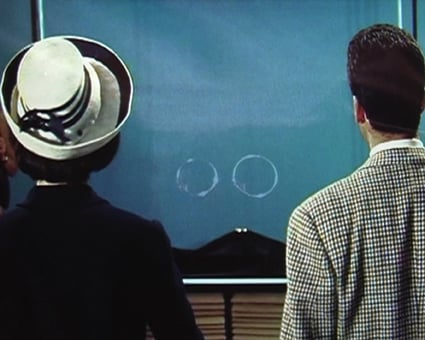Tarantism
2007 - Film & Video (Film & Video)
9,17 min
Joachim Koester
Tarantism is the name of disease which appeared in southern Italy, resulting from the bite of a spider called Tarantula. This bite caused various symptoms, such as nausea, difficulty to speak, delusion, excitability and agitation. The victims suffered then from convulsions and the only way to heal them was to engage in a frenzied dance, as it was believed. Called “Tarantella”, this dance, appeared during the Middle Ages and was danced all along the 19th century. To make this video, the artist asked a group of dancers to perform this uncontrolled dance in order to explore this borderline mental and physical state, close to a trance. Tarantism represents a transition in the artist’s work, who brings a story back to life simply through the movement of these completely disarticulate bodies, without referring to images extracted from reality, thus exploring a purely mental territory.
With a keen interest in the stranger corners of the long human story, and a persistent interest in the supernatural, the transcendent, and the psychedelic, Joachim Koester’s work follows the artists own undying interest in physical and psychological limits. While exploration was a matter of crossing geographies before the 19th century, the 20th century brought the mental exploration of our unconscious, hastened by the discovery of psychoanalysis. Koester is interested in visualizing specific events—those forgotten, overlooked, or suppressed by the official historical record—in order to reintroduce them into collective memory. Using 16mm documentary films, photographic series or books, his work transforms stories into images and vice versa, appearing as a quest for the invisible and the vanishing.
Colors:
Related works of genres: » video artists

© » KADIST
Haris Epaminonda
2007Created from extracts of kitsch movies or Greek soap operas from the 1960s, these videos are like audiovisual ‘postcards’ reflecting a nostalgic and melancholic approach...

© » KADIST
Haris Epaminonda
2007Haris Epaminonda’s work questions the manipulation and the flow of images as well as their power of fascination...

© » KADIST
Haris Epaminonda
2012Haris Epaminonda’s work questions the manipulation and the flow of images as well as their power of fascination...

© » KADIST
Korakrit Arunanondchai
2017His untitled paintings express his concern regarding perception in abstract form...

© » KADIST
Walid Raad
2022For his first NFT release artist Walid Raad made a series of animated birthday cakes, titled Festival of Gratitude , for some of the world’s most toxic and larger-than-life leaders...

© » KADIST
Walid Raad
2009“The Lebanese wars of the past three decades affected Lebanon’s residents physically and psychologically: from the hundred thousand plus who were killed; to the two hundred thousand plus who were wounded; to the million plus who were displaced; to the even more who were psychologically traumatized...

© » KADIST
Sebastián Díaz Morales
2014In Suspension a young man is hanging in the air, falling, or perhaps drifting through time and space...

© » KADIST
Sebastián Díaz Morales
2012Pasajes I is the first in a series of Sebastián Díaz Morales’s four videos Pasajes , which focuses on a solitary man walking through Buenos Aires...

